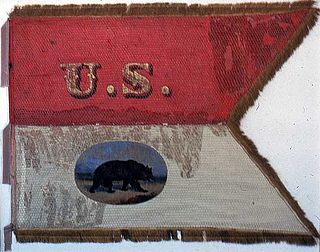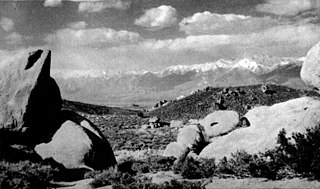
Fort Walla Walla is a United States Army fort located in Walla Walla, Washington. The first Fort Walla Walla was established July 1856, by Lieutenant Colonel Edward Steptoe, 9th Infantry Regiment. A second Fort Walla Walla was occupied September 23, 1856. The third and permanent military Fort Walla Walla was built in 1858 and adjoined Steptoeville, now Walla Walla, Washington, a community that had grown up around the second fort. An executive order on May 7, 1859 declared the fort a military reservation containing 640 acres devoted to military purposes and a further 640 acres each of hay and timber reserves. On September 28, 1910 soldiers from the 1st Cavalry lowered the flag closing the fort. In 1917, the fort briefly reopened to train men of the First Battalion Washington Field Artillery in support of action in World War I. In 1921, the fort and property were turned over to the Veterans Administration where 15 original buildings from the military era remain. Today, the complex contains a park, a museum, and the Jonathan M. Wainright Memorial VA Medical Center.

California's involvement in the American Civil War included sending gold east to support the war effort, recruiting volunteer combat units to replace regular U.S. Army units sent east, in the area west of the Rocky Mountains, maintaining and building numerous camps and fortifications, suppressing secessionist activity and securing the New Mexico Territory against the Confederacy. The State of California did not send its units east, but many citizens traveled east and joined the Union Army there, some of whom became famous.

The Pacific coast theater of the American Civil War consists of major military operations in the United States on the Pacific Ocean and in the states and Territories west of the Continental Divide. The theater was encompassed by the Department of the Pacific that included the states of California, Oregon, and Nevada, the territories of Washington, Utah, and later Idaho.

The 2nd Massachusetts Volunteer Cavalry Regiment was a regiment of cavalry troops in the Union army during the American Civil War. It consisted primarily of men from the states of California and Massachusetts, and served in the Eastern Theater, despite its western roots.

The Colorado Territory was formally created in 1861 shortly before the bombardment of Fort Sumter sparked the American Civil War. Although sentiments were somewhat divided in the early days of the war, Colorado was only marginally a pro-Union territory. Colorado was strategically important to both the Union and Confederacy because of the gold and silver mines there as both sides wanted to use the mineral wealth to help finance the war. The New Mexico Campaign was a military operation conducted by Confederate Brigadier General Henry Sibley to gain control of the Southwest, including the gold fields of Colorado, the mineral-rich territory of Nevada and the ports of California. The campaign was intended as a prelude to an invasion of the Colorado Territory and an attempt to cut the supply lines between California and the rest of the Union. However, the Confederates were defeated at the Battle of Glorieta Pass in New Mexico and were forced to retreat back to Texas, effectively ending the New Mexico Campaign.

The area that eventually became the U.S. state of Montana played little direct role in the American Civil War. The closest the Confederate States Army ever came to the area was New Mexico and eastern Kansas, each over a thousand miles away. There was not even an organized territory using "Montana" until the Montana Territory was created on May 26, 1864, three years after the Battle of Fort Sumter. In 1861, the area was divided between the Dakota Territory and the Washington Territory, and in 1863, it was part of the Idaho Territory.

The 2nd Regiment California Volunteer Cavalry was a cavalry regiment in the Union Army during the American Civil War. It spent its entire term of service in the western United States, with most of its companies dispersed to various posts.
Fort Gaston was founded on December 4, 1859, in the redwood forests of the Hoopa Valley, in Northern California, on the west bank of the Trinity River, 14 miles (23 km) from where the Trinity flows into the Klamath River. It was located in what is now the Hoopa Valley Indian Reservation. Fort Gaston as part of the Humboldt Military District was intended to control the Hupa Indians and to protect them from hostile white settlers. The post was named for 2nd Lieutenant William Gaston, of the First Dragoons, who had been killed May 17, 1858, during the Spokane–Coeur d'Alene–Paloos War.
The Company A, Arizona Rangers was a cavalry formation of the Confederate States Army during the American Civil War.

The 1st Regiment California Cavalry was a cavalry regiment in the Union Army during the American Civil War. First formed as a battalion, the unit later expanded to regimental size.
Charles D. Beckwith was an early frontier photographer who operated studios in California, Utah and Idaho during the late nineteenth century.
Hispanics in the American Civil War fought on both the Union and Confederate sides of the conflict. Not all the Hispanics who fought in the American Civil War were "Hispanic Americans" — in other words citizens of the United States. Many of them were Spanish subjects or nationals from countries in the Caribbean, Central and South America. Some were born in what later became a U.S. territory and therefore did not have the right to U.S. citizenship. It is estimated that approximately 3,500 Hispanics, mostly Mexican-Americans, Puerto Ricans and Cubans living in the United States joined the war: 2,500 for the Confederacy and 1,000 for the Union. This number increased to 10,000 by the end of the war.

The role of Washington Territory in the American Civil War is atypical, as the territory was the most remote from the main battlefields of the conflict. The territory raised a small number of volunteers for the Union Army, who did not fight against the Confederate States Army but instead maintained defensive positions against possible foreign naval or land attacks. Although the Indian Wars in Washington were recent, there were no Indian hostilities within the area of modern Washington, unlike the rest of the western states and territories, during the Civil War. At the start of the American Civil War, modern-day Washington was part of the Washington Territory. On March 3, 1863, the Idaho Territory was formed from that territory, consisting of the entirety of modern-day Idaho, Montana, and all but southwest Wyoming, leaving the modern-day Washington as Washington Territory.

The Owens Valley War was fought between 1862 and 1863 by the United States Army and American settlers against the Mono people and their Shoshone and Kawaiisu allies in the Owens Valley of California and the southwestern Nevada border region. The removal of a large number of the Owens River indigenous Californians to Fort Tejon in 1863 was considered the end of the war. Minor hostilities continued intermittently until 1867.
The following list is a Bibliography of American Civil War Union military unit histories. More details on each book are available at WorldCat.
The California Indian Wars were a series of wars, battles, and massacres between the United States Army, and the Indigenous peoples of California. The wars lasted from 1850, immediately after Alta California, acquired during the Mexican–American War, became the state of California, to 1880 when the last minor military operation on the Colorado River ended the Calloway Affair of 1880.

The 1st Massachusetts Volunteer Cavalry Regiment was a cavalry regiment that served in the Union Army during the American Civil War.
The 3rd Massachusetts Volunteer Cavalry Regiment was a cavalry regiment that served in the Union Army during the American Civil War. It was organized by consolidating the 41st Massachusetts Mounted Infantry and the 2nd Battalion Massachusetts Cavalry on June 17, 1863. The regiment served with the XIX Corps, Army of the Gulf during the Red River Campaign in 1864. Its heaviest combat during this campaign took place during the Battle of Sabine Crossroads.










